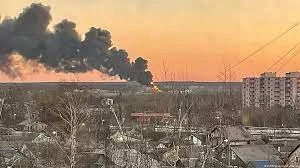In an alarming incident that unfolded in the early hours of Wednesday, Peskov Airport, located in the Russian city of Peskov, became the target of a drone attack. The assault coincided with a determined response from defense forces who swiftly engaged in repelling the attack.
Videos circulating on various social media platforms captured the unsettling scene, showcasing thick plumes of black smoke billowing over the airport grounds, indicating the severity of the attack.
Mikhail Vedernikov, the regional governor, took to Telegram to report the unfolding situation. He stated that the defense ministry was actively countering the drone attack at Peskov’s airport. Governor Vedernikov himself arrived at the scene promptly, offering insight into the situation. Fortunately, preliminary information indicated that there were no reported casualties, although the extent of the damage caused by the attack is still under assessment.
Emergency services, as reported by TASS news agency, confirmed that four Il-76 transport planes suffered damage while situated on the airport’s grounds. In response to the security threat, Russian authorities opted to close the airspace in the surrounding region to prevent any further potential risks.
Reports emerging from the Russian outlet Readovka shed light on the nature of the attack. Allegedly, around 15 drones originating from Ukrainian sources carried out the assault on the airport. Notably, these drones were met with countermeasures and were reportedly taken down, some of them through the use of small arms fire.
Pskov, the location of the airport, stands approximately 700 kilometers north of Ukraine. The proximity to the border of NATO member Estonia adds a layer of complexity to the situation. Additionally, the city of Pskov is located just 30 kilometers from the border, while Latvia is positioned about 60 kilometers southwest of the city.
As investigations unfold, this incident underscores the evolving challenges posed by unmanned aerial vehicles in modern conflicts and the critical role of defense mechanisms in safeguarding vital infrastructure.




